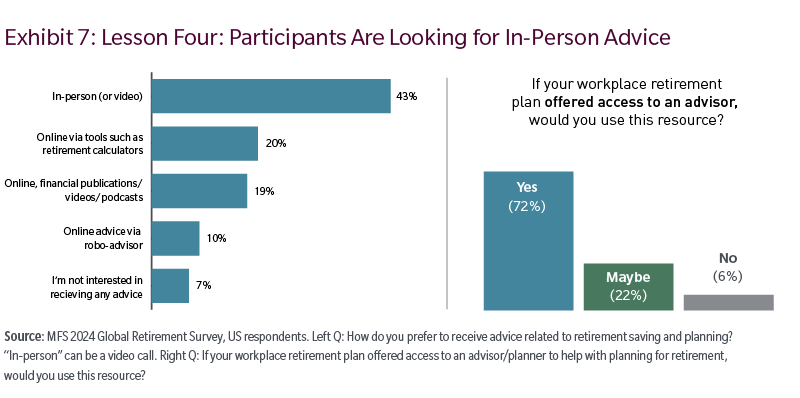
The Retirement Income Dilemma
Retirement income is top of mind for many plan sponsors these days. In this paper, explore what MFS is solving for and what have we have learned so far.
Jeri Savage
Retirement Lead Strategist
In brief:
- Retirement income is top of mind for many plan sponsors these days. Often, we find that the conversation focuses solely on products: What types of funds should sponsors consider that can help deliver a retirement income solution for their participants?
- We think the conversation should focus on creating and articulating a retirement income philosophy based on an understanding of the retirement income problem, the state of the market and lessons we have learned so far.
- We’ve developed a retirement income roadmap to help sponsors determine if they want to offer an Accumulation Plan or a Destination Plan.
- We note that this should not be a “one and done” process. Sponsors should periodically revisit and refine their strategy as plan demographics, business needs or retirement income landscapes change over time.
The Retirement Income Problem
Demographics are driving the retirement income discussion. The statistics in Exhibit 1 help paint the picture of an aging workforce with doubts about their ability to retire comfortably.

The retirement income challenge offers an opportunity to align corporate objectives with employee retirement goals. To do this, we suggest sponsors design a Retirement Income Plan Road Map. The journey begins with an assessment of participant needs along with an understanding of the current state of the retirement income landscape. From there, a sponsor can begin to articulate their retirement income philosophy, which could lead to one of two potential types of plans.



The first plan type is an Accumulation Plan that focuses on accumulating balances throughout the working years — participants tend to exit the plan once they retire. The second type is a Destination Plan, one that actively works to retain retirees in the plan.
If, for example, the philosophy points to a Destination Plan, the sponsor can take steps to establish the proper plan design, determine which options should be available in the investment menu and implement the supporting services needed to help participants retire and stay in the plan. With the Accumulation Plan, the sponsor offers supporting services to help retirees transition into retirement and, potentially, out of the plan.
There is no right or wrong answer, but we think this approach is a useful framework for sponsors to address the retirement income challenge and navigate the often-confusing retirement income landscape.
State of the Retirement Income Landscape
As noted earlier, it's important for sponsors to understand the retirement income landscape, including regulatory and legislative developments, the state of Social Security and the solutions currently available in the marketplace.
Over the past decade, there have been several regulatory and legislative developments pertaining to retirement income. In particular, the Secure Act and Secure 2.0 included a variety of provisions designed to make it easier for plan sponsors to implement retirement income provisions.
However, it’s not all good news. The Social Security Trust Fund is expected to be depleted by 2035 when it's estimated that tax income will fund only 83% of scheduled benefits.7 Social Security forms the retirement income foundation for most Americans and any shortfall could have wide ranging implications for how and when employees retire, potentially creating challenges to an employer’s ability to effectively manage their workforce. At present, there are currently no meaningful legislative initiatives to address this critical issue.
Next, we highlight in Exhibit 3 the key features of the retirement income solutions that exist in the marketplace today and how they might fit into a retirement plan menu.

Some key takeaways from Exhibit 3 include:
- There is a wide variety of options under the retirement income solutions umbrella.
- There are tradeoffs when it comes to the features and benefits of these solutions. For example, solutions without guaranteed income components tend to be more liquid than those that offer some form of guarantee.
- Given the complexity of the various solutions, it's unlikely that adding just one solution will solve all the retirement income needs of any one plan’s participant base.
- Appropriate retirement income solutions will depend on plan sponsors' overall retirement income philosophy that aligns with the workforce and plan characteristics.
Lessons Learned (So Far)
The retirement income conversation has been ongoing for several years, and we believe there are four lessons learned.
First, retirement concerns are universal. Our global retirement survey asked participants across the United States, Canada, the United Kingdom and Australia for their views on retirement. We show the results of several questions in Exhibit 4. It is noteworthy how consistent the responses are across different markets.
Retirement concerns are universal. We are more alike than different.
The second lesson is that retirement income presents potential drawbacks, and in-plan retirement income solutions may not be a fit for all plan sponsors.
The third lesson is there is no one-size-fits-all solution to the decumulation puzzle. Our global retirement survey asked “What assets do you expect to use in retirement?” Exhibit 6 shows the wide array of income sources that participants identified and demonstrates that everyone’s puzzle pieces are different. Participants could potentially benefit from advice to help put these pieces together into a cohesive retirement income plan.
In-plan retirement solutions are not a fit for all plan sponsors.

Participants could potentially benefit from some form of advice to help put these pieces together into a cohesive retirement income plan.
That brings us to lesson four, which is that participants are looking for advice — in-person advice.
Plan sponsors may want to offer access to advisors —whether it's affiliated with the recordkeeper, managed account service or an independent firm.
This point of access is important. We aren't suggesting that plan sponsors directly provide advice. Rather, sponsors have an opportunity to position the plan as a resource from which participants can access advice, education and tools. That access can be affiliated with the plan’s recordkeeper, managed account service or through an independent firm.
This brings us back to our roadmap to help plan sponsors navigate through this complex topic. It starts with a fundamental question: Do you want to sponsor an accumulation plan where participants accumulate assets and exit the plan upon retirement, or a destination plan where participants are encouraged to stay in the plan upon retirement.

Choose an identity and ensure the plan's design, investment menu, and services reflect it.
There is no right or wrong answer, and different sponsors will come to different conclusions based on their circumstances. For those that want to sponsor a destination plan, there are three key dimensions to consider:
1. The plan’s design, in particular its ability to allow for flexible distribution options in retirement
2. The investment menu, what investments are you offering to keep retirees in the plan and what level of guaranteed options make sense
3. Supporting services, including tools and potentially access to advice
Too often we find that the retirement income conversation is almost wholly focused on investment products that can be added to a DC plan menu as the proverbial silver bullet solution. While investments will undoubtedly be an important component of a plan’s approach to positioning itself as a destination plan, we believe decisions regarding the plan’s design and how it will support retired participants are just as important.
7 Social Security Administration 2024 Annual Report.
Distributed by: U.S. – MFS Institutional Advisors, Inc. (“MFSI”), MFS Investment Management and MFS Fund Distributors, Inc., Member SIPC, Boston, MA
The views expressed are subject to change at any time.. These views are for informational purposes only and should not be relied upon as a recommendation to purchase any security or as a solicitation or investment advice from the Advisor. No forecasts can be guaranteed.
Unless otherwise indicated, logos and product and service names are trademarks of MFS® and its affiliates and may be registered in certain countries.
MFS® does not provide legal, tax, social security or accounting advice. Clients of MFS should obtain their own independent tax and legal advice based on their particular circumstances. No forecasts can be guaranteed.
Survey Methodology:
Audience: Ages 18+, employed at least part-time. Active workplace retirement plan participants/members and retirees in the US, Canada, UK, and Australia.* Data weighted to mirror the age/gender distribution of the workforce in each country. Methodology: Mode: 15 minute online survey. MFS not revealed as the sponsor. Field period: March 8 – April 13, 2024. Key Topics of Inquiry: Impact of market events, retirement confidence and advice, target date funds, retirement income and sustainability.
*To qualify in each region: US, actively contributing to or retired from a 401(k), 403(b), 457, or 401(a)/Canada, actively contributing to or retired from a DC Pension Plan, Group Registered Retirement Savings Plan, Deferred Profit Sharing Plan, Non-Registered Group Savings Plan, or Simplified Employee Pension Plan/UK, actively contributing to or retired from a Defined Contribution Scheme, Master Trust, or Individual Savings Account./Australia, actively contributing to or retired from an industry, retail, corporate or public sector super fund or a self-managed super fund.

